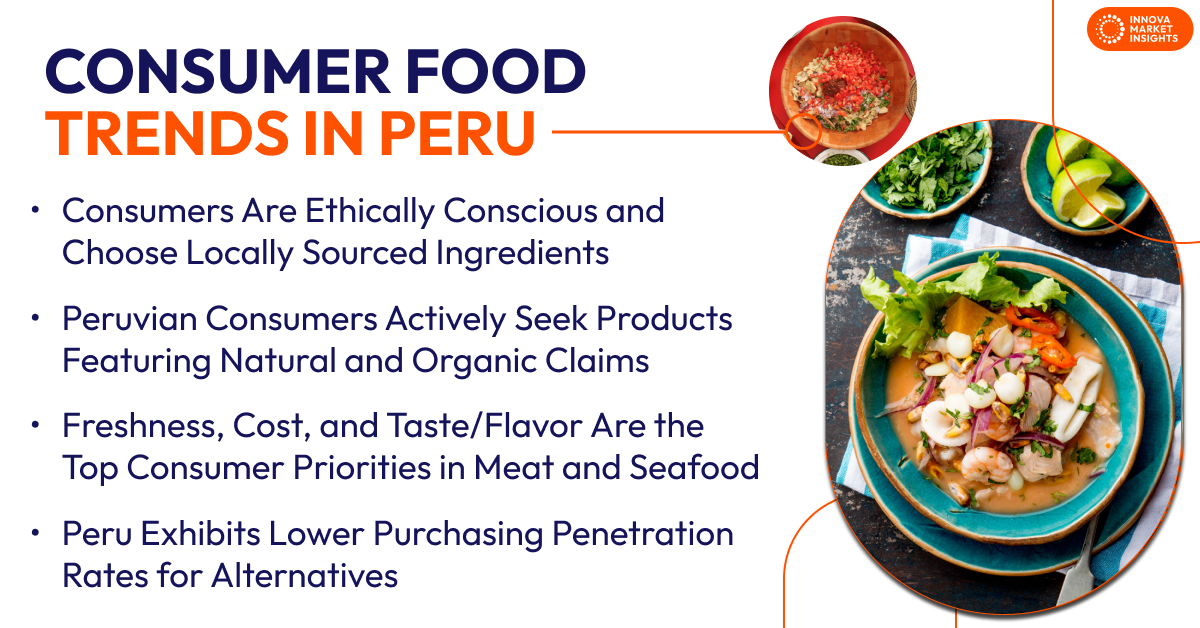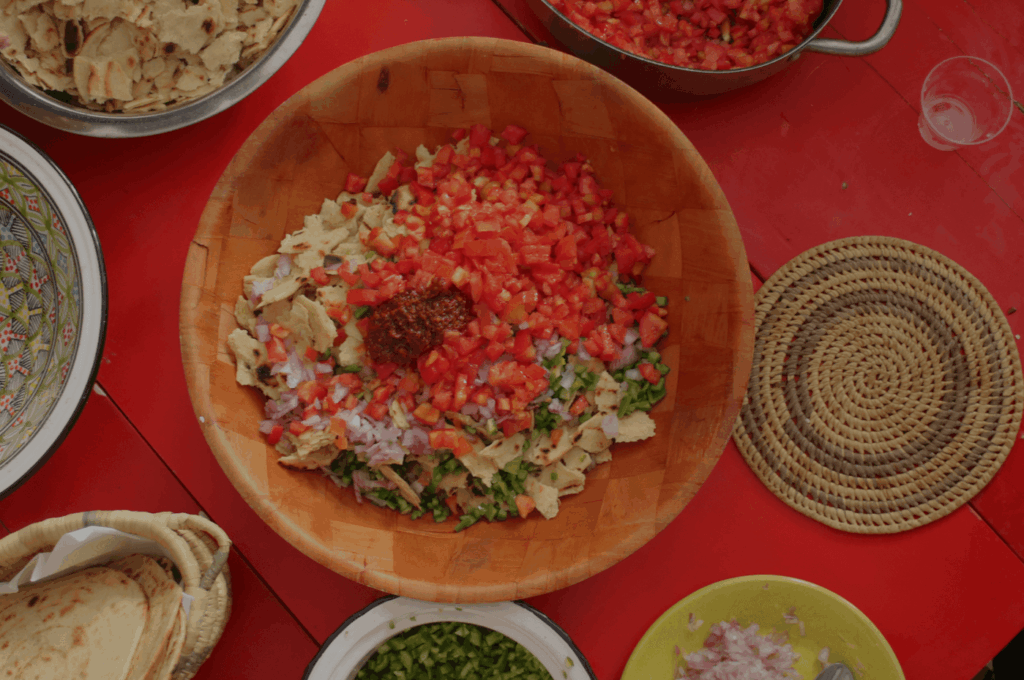August 15, 2025 – Consumption of food and beverages in Peru has undergone change, held up by factors in specific categories that have impacted consumer habits. After a comprehensive analysis of everything from everyday staple foods to plant-based dietary precisions, Innova Market Insights takes a look at important drivers and opportunities for the market in the country.
Coping With Climate Change and Other Challenges
Consumers care about the planet, more so than ever. Climate change is affecting food security and health, forcing a refocus on strategies to cope and limit the foreseeable effects. Health concerns over obesity and mental health have had an impact on the wider world, meaning that what is consumed is scrutinized more than ever. All of this uncertainty means shoppers seek reassurance, as well as honesty and transparency.
Important Drivers in Peru
Lifestyle choices have transformed for the average person, with more emphasis being put on food to support them in their goals. High fiber and protein foods with low sugar claims or even reduced fat are now commonplace, as are functional ingredients that have omega-3 and 6. One of the big drivers though, is bread products, especially ones with whole grain and multi-grain compositions, which are favored for their nutritional density.
There is a preference for natural products, along with those that are healthier and contain no artificial flavors, as they are perceived to be more authentic. Consumers have become more ethically conscious with their choice of locally sourced ingredients too, while caffeine-free soft drinks are proving to be more attractive. There is also room in the market now for new flavors and unique formats, meaning Peruvians are willing to delve a little more into their curiosity. Overall, Innova Market Insights observed that a balance is sought from shoppers who want cost-effective products that hold true to higher quality claims.
A Notable Decline in Alcoholic and Non-Alcoholic Drinks
Alcohol purchasing penetration is lower than the global average in Peru, where the most popular categories of drinks are beer, wine, sparkling wine and champagne. Cost and awareness of alcoholic consumption have impacted sales and contributed to this decline. Health considerations, evolving taste preferences, and lifestyle changes also play key roles in shaping current consumption patterns. Taste and flavor rule above all else when it comes to preferences and influencing choice, with nearly half of all consumers citing this across all categories. Other factors driving demand were cost, freshness, and health-conscious choices. Non alcoholic beverages are impacted by similar attributes, with freshness being the main factor compelling consumption of non-alcoholic beverages, cited by nearly half of consumers.

Healthier Options Are Behind Increasing Soft Drink Intake
Bottled water is the leading choice for health-conscious consumers, remaining the top choice among consumers due to its perceived health benefits. Food trends reveal that no artificial flavors and colors are a key claim among others. When it comes to significant claims for bottled water; product safety, natural ingredients and organic claims were top of mind. While in soft drinks, health was the fundamental aspect of consideration, with taste and flavor being the number one reason for purchasing. For consumers of iced tea, for example, organic, product safety, sugar reduction, caffeine-free and natural were and still are the top attributes in decisions. While sugar reduction, no artificial flavors or colors, natural, organic, and high protein are considered the most important claims in juices and smoothies.
Coffee and Tea Consumption in Peru
A top priority for Peruvian consumers is taste and flavor in their coffee and tea, with nearly 60% fueling this trend and proving a distinct drinking habit. Then freshness follows as a secondary consideration, valued by 33% for coffee and 56% for tea drinkers. Natural ingredients take precedence in the hot drinks market, as Peruvian consumers actively seek products featuring natural components, organic certification, and reduced sugar content. The absence of artificial flavors and colors significantly influences their beverage choices. Hot coffee accompanies breakfast for more consumers than the global average in this category. Tea consumption follows similar patterns, demonstrating Peruvians’ preference for hot beverages throughout the day. They also tend to enjoy hot drinks most during breakfast and dinner.
Taste and Health Claims Shape Bread and Cereal Purchases
In Peru, bread and bread products have a purchasing penetration rate of 76%, which is just below the global average of 77%. When it comes to bread, more than half of Peruvians regard taste, flavor, cost and freshness as their key considerations in their bread products, while whole grain and high fiber claims drive bread choices. A quarter of consumers in the country cite claims on whole grain/multi-grain content, high fiber and locally sourced/produced ingredients as the top considerations in bread products. Although for the purchasing penetration of breakfast cereals, it is just below that of the global average by a mere 1% with taste/flavor and cost being the top attributes.
Peru’s Dairy Market Thrives on Health Benefits and Clean Label Appeal
Yogurt and cheese lead dairy demand in Peru, with the dairy purchasing penetration rate in the country standing at 70%, just under the global average of 71%. There has been an increased demand observed in yogurt and cheese consumption throughout this category. Although, milk and flavored milk exhibit a lower penetration rate in comparison. Three primary factors influence Peruvian dairy purchases: taste/flavor, cost, and freshness rank the highest with more than two in five consumers citing these attributes as decisive across all dairy categories. Health and ingredient preferences align as functional ingredients, fat reduction and high protein are favored by a quarter of the population. Last, but not least, food trends in Peru show that almost one-third of consumers favor the presence of functional ingredients in flavored milk.
Navigating Challenges in Meat and Fish Consumption
Freshness, cost, and taste/flavor are the top consumer priorities in Peru’s meat and seafood consumption. Additionally, health aspects are an influential factor, cited by more than a fifth of consumers in each category. Peruvians want nutrients and safety concerns addressed in their products. They also want a high omega-3/6 and protein content in fish/seafood and meat/poultry, cited by more than two in five consumers across both categories. A pivotal area sought after by a quarter of consumer preferences includes products with claims related to safety, locally sourced/produced ingredients and reduced fat.
Peruvian Consumers Seek Healthy and Affordable Meal Preparations
Overall, consumers want healthy eating and affordable meals and this has led to an increase in categories such as stocks and seasonings for example, which have risen by 16%. In other meal preparation categories, there has been a decline and this can be attributed to health concerns and lifestyle changes. More than half of Peruvian consumers prefer taste and flavor over anything else as long as they contain key factors like natural ingredients, low sugar and fat spreads. Notably, taste/flavor and cost surpass the global average, while convenience is cited by 24% of consumers, reflecting current food trends in Peru.
Health Concerns Impact Snack Consumption
In Peru, penetration for snacks and treats is below the global average with the exception of sweet biscuits and cookies, which remain high at 67%. Aside from cereal and energy bars, there has been reduced consumption across all categories. This is due to changes in lifestyles, budgets, and health. More than half of consumers prefer taste and flavor over any other attribute with locally sourced and traditionally made products being the key selling points. Functional ingredient claims in snacks are largely preferred by 24% of consumers, surpassing the global average of 17%.
Peruvians Embrace Plant-Based Food and Functional Nutrition
Across all categories of plant-based foods and special diets, Peru exhibits lower purchasing penetration rates for all categories. Food trends in Peru show that meat substitutes, dairy alternatives and sports/functional nutrition were all below the global average as well. Budgets and health make these categories indispensable and have led to an increase of intake. A third of all consumers factor in taste/flavor along with cost and freshness into their thinking when buying alternatives to meat and dairy. There is a preference in this category for functional ingredients, high fiber and protein content, and reduced sugar. While Peruvians are particularly fond of products that also boast safety and scientifically proven claims.
What’s Next for Growth Drivers in Peru?
A number of key preferences exist in Peru for a multitude of categories. Whether it is a staple purchased and influenced by cost and freshness, or others that contain taste or flavor in functional food and beverage for fitness and dietary goals. It is obvious by this report and the findings within it that products that cater to desire for gut-friendly drinks and nutrient-rich snacks benefit the most and will continue to. Equally, native Peruvian superfoods like quinoa, maca, and kiwicha will be part of this and continue to fuel demand for plant-based protein products. Additionally, natural products with clean labels and eco-friendly packaging can add to a product’s authenticity.
Peruvian consumers will continue to see taste and flavor as their top priority. This has a knock on effect for global food and diverse offerings, presenting opportunites. Cost-effective meals with nutrition packed in and freshness will impact choice. While textures and colors will enhance appeal across the board. Value in nutritious options, particularly in staples, dairy, and snacks will be favored while using local ingredients and simple recipes can help to lower costs.
This article is based on Innova’s Category Growth Drivers in Peru report. This report is available to purchase or with an Innova Reports subscription. Reach out to find out more
